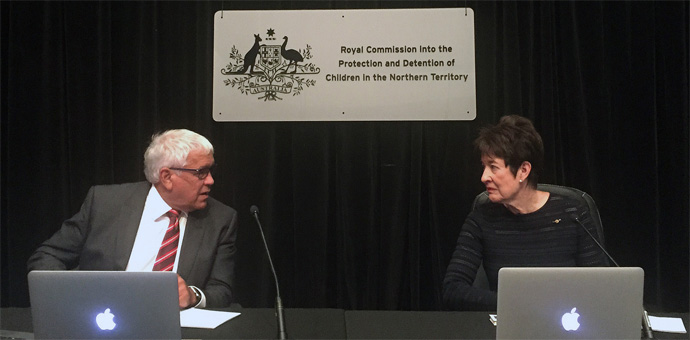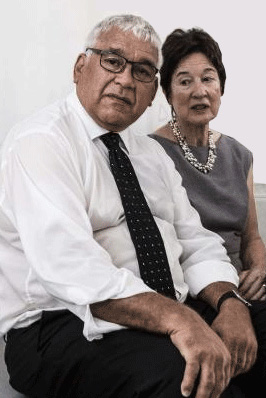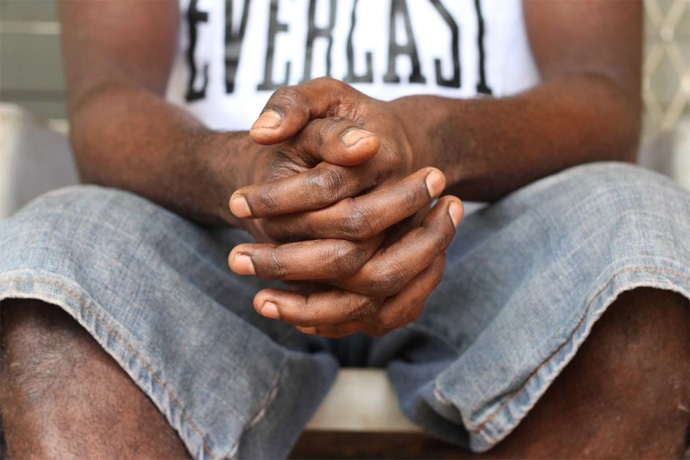The invisibility of young peoples voices in the Don Dale royal commission’s interim report
 Northern Territory Youth Detention Royal Commissioners Mick Gooda and Margaret White
Northern Territory Youth Detention Royal Commissioners Mick Gooda and Margaret White(The Australian)
Young people’s voices are all but invisible in the Don Dale royal commission’s interim report
By Thalia Anthony
Associate Professor in Law, University of Technology Sydney
6 April 2017
It’s been just over eight months since the screening of images of Dylan Voller shackled and hooded in a restraint chair, unprovoked bashing of children by prison guards, and young boys being gassed in Northern Territory youth detention. The national outcry prompted the announcement of a royal commission to investigate the issues.

Mick Gooda and Margaret White
The commission’s terms of reference extended to the NT child protection system in recognition of the many kids who journey through both this and the youth detention system. However, these did not make reference to the cultural needs of Indigenous young people, who make up the overwhelming proportion of children in these systems.
Despite expectations, the commission’s much-anticipated interim report, released last week, did not deliver any findings or make any recommendations. Nor did it reflect young people’s personal stories.
Interim report lacks recommendations
Second, the since-elected NT Labor government has refrained from making any substantive changes to youth detention or child protection until the commission’s findings are handed down. In the meantime, children in the NT continue to be sent to youth detention facilities at increasing rates.
The report’s failure to deliver any findings or make any recommendations is a far cry from the approach of the Royal Commission into Aboriginal Deaths in Custody. Notwithstanding ongoing investigations, its interim report outlined detailed recommendations that precipitated immediate reforms.
Even the recent visit of the UN special rapporteur on the rights of indigenous peoples, Victoria Tauli-Corpuz, produced a preliminary report. It had recommendations such as:
-
increasing the age of criminal responsibility;
-
providing children with dignity and respect in detention;
-
supporting Indigenous community-led diversion; and
-
greater engagement with Indigenous families and communities in decision-making processes around child protection.
The commission did outline some interim observations. These included that:
There is a strong perception that the system of detention in the Northern Territory is failing.
That youth detention is:
… likely to leave children and young people more damaged than when they entered.
… punitive, not rehabilitative.
That the centres are:
… harsh, bleak and not in keeping with modern standards.
And that:
The youth justice and child protection systems in the NT are inextricably linked.
Children’s voices are missing
In contrast, the interim report of the ongoing Royal Commission into Institutional Responses to Child Sexual Abuse had an entire volume dedicated to the personal stories and poetry of abuse survivors across various institutional settings.
Research by Holly Doel-Mackaway demonstrates the importance of engaging Indigenous young people in decision-making on matters that affect them. Her research in relation to the NT Intervention found Indigenous young people had informed views about the policy, but that their voices were not included in the decision-making.
The NT royal commission’s interim report opens with coverage of statistics on rates of youth incarceration and child protection. These statistics may paint a picture of a systemic problem. However, they also run the risk of dehumanising young people’s experiences.
Juanita Sherwood and others emphasise the importance of storytelling in conveying the experiences of Indigenous people in the criminal justice system and in effecting change. The stories told to the commission convey the pain from:
-
weeks spent in isolation cells;
-
young girls being forcibly stripped by male officers;
-
random attacks by officers;
-
punitive restraints; and
-
there being no avenues of support when these children were at the mercy of youth detention officers.
Dylan Voller gave evidence that while he was hooded in his restraint chair for hours he thought:
… there’s no-one in there, no responsible person that could have – that would have said, “That’s enough”, that, “We need to get him out of that restraint chair, he has been in there for too long.”
In addition to the harm in youth detention and child protection placements, stories have also expressed the benefits of cultural programs and the need for Indigenous community-run programs.
These stories, from both children and elders, are lost in a narrative that focuses on institutions. Yet they are critical for informing change that recognises the vital role of family, community and country in Indigenous young people’s lives.
Young people who have given evidence have expressed disappointment at the interim report’s limited scope, which Voller has publicly articulated. For him, the detention conditions were not only punitive, as the commission’s report described them, but unjustifiably violent.
The final report, which is due on August 1, will be the next opportunity to dignify the young people whose suffering hastened the inquiry.
This report must not only make findings and recommendations that recognise the harm inflicted on them and promote reparations, accountability and a shift in the approach to youth detention and child protection in the NT, but also be a platform to convey the words of these young people whose voices were silenced for too long.

(NACCHO Communications)
Dr Thalia Anthony's expertise is in the areas of criminal law and procedure and Indigenous people and the law, with a particular specialisation in Indigenous criminalisation and Indigenous community justice mechanisms. - More
Previously Published in The Conversion

